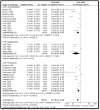Community-based interventions for the prevention and control of helmintic neglected tropical diseases
- PMID: 25114793
- PMCID: PMC4128617
- DOI: 10.1186/2049-9957-3-23
Community-based interventions for the prevention and control of helmintic neglected tropical diseases
Abstract
In this paper, we aim to systematically analyze the effectiveness of community-based interventions (CBIs) for the prevention and control of helminthiasis including soil-transmitted helminthiasis (STH) (ascariasis, hookworms, and trichuriasis), lymphatic filariasis, onchocerciasis, dracunculiasis, and schistosomiasis. We systematically reviewed literature published before May 2013 and included 32 studies in this review. Findings from the meta-analysis suggest that CBIs are effective in reducing the prevalence of STH (RR: 0.45, 95% CI: 0.38, 0.54), schistosomiasis (RR: 0.40, 95% CI: 0.33, 0.50), and STH intensity (SMD: -3.16, 95 CI: -4.28, -2.04). They are also effective in improving mean hemoglobin (SMD: 0.34, 95% CI: 0.20, 0.47) and reducing anemia prevalence (RR: 0.90, 95% CI: 0.85, 0.96). However, it did not have any impact on ferritin, height, weight, low birth weight (LBW), or stillbirths. School-based delivery significantly reduced STH (RR: 0.49, 95% CI: 0.39, 0.63) and schistosomiasis prevalence (RR: 0.50, 95% CI: 0.33, 0.75), STH intensity (SMD: -0.22, 95% CI: -0.26, -0.17), and anemia prevalence (RR: 0.87, 95% CI: 0.81, 0.94). It also improved mean hemoglobin (SMD: 0.24, 95% CI: 0.16, 0.32). We did not find any conclusive evidence from the quantitative synthesis on the relative effectiveness of integrated and non-integrated delivery strategies due to the limited data available for each subgroup. However, the qualitative synthesis from the included studies supports community-based delivery strategies and suggests that integrated prevention and control measures are more effective in achieving greater coverage compared to the routine vertical delivery, albeit it requires an existing strong healthcare infrastructure. Current evidence suggests that effective community-based strategies exist and deliver a range of preventive, promotive, and therapeutic interventions to combat helminthic neglected tropical diseases (NTDs). However, there is a need to implement and evaluate efficient integrated programs with the existing disease control programs on a larger scale throughout resource-limited regions especially to reach the unreachable.
Keywords: Community-based interventions; Neglected tropical diseases; Soil-transmitted helminthiasis.
Figures
References
-
- Hotez PJ, Bundy DAP, Beegle K, Brooker S, Drake L, de Silva N, Montresor A, Engels D, Jukes M, Chitsulo L. Helminth infections: soil-transmitted helminth infections and schistosomiasis. 2006. - PubMed
-
- Crompton DWT, Nesheim MC. Nutritional impact of intestinal helminthiasis during the human life cycle. Annu Rev Nutr. 2002;22(1):35–59. - PubMed
-
- Miguel E, Kremer M. Worms: identifying impacts on education and health in the presence of treatment externalities. Econometrica. 2004;72(1):159–217.
-
- Hotez PJ, Molyneux DH, Fenwick A, Kumaresan J, Sachs SE, Sachs JD, Savioli L. Control of neglected tropical diseases. N Engl J Med. 2007;357(10):1018–1027. - PubMed
LinkOut - more resources
Full Text Sources
Other Literature Sources






